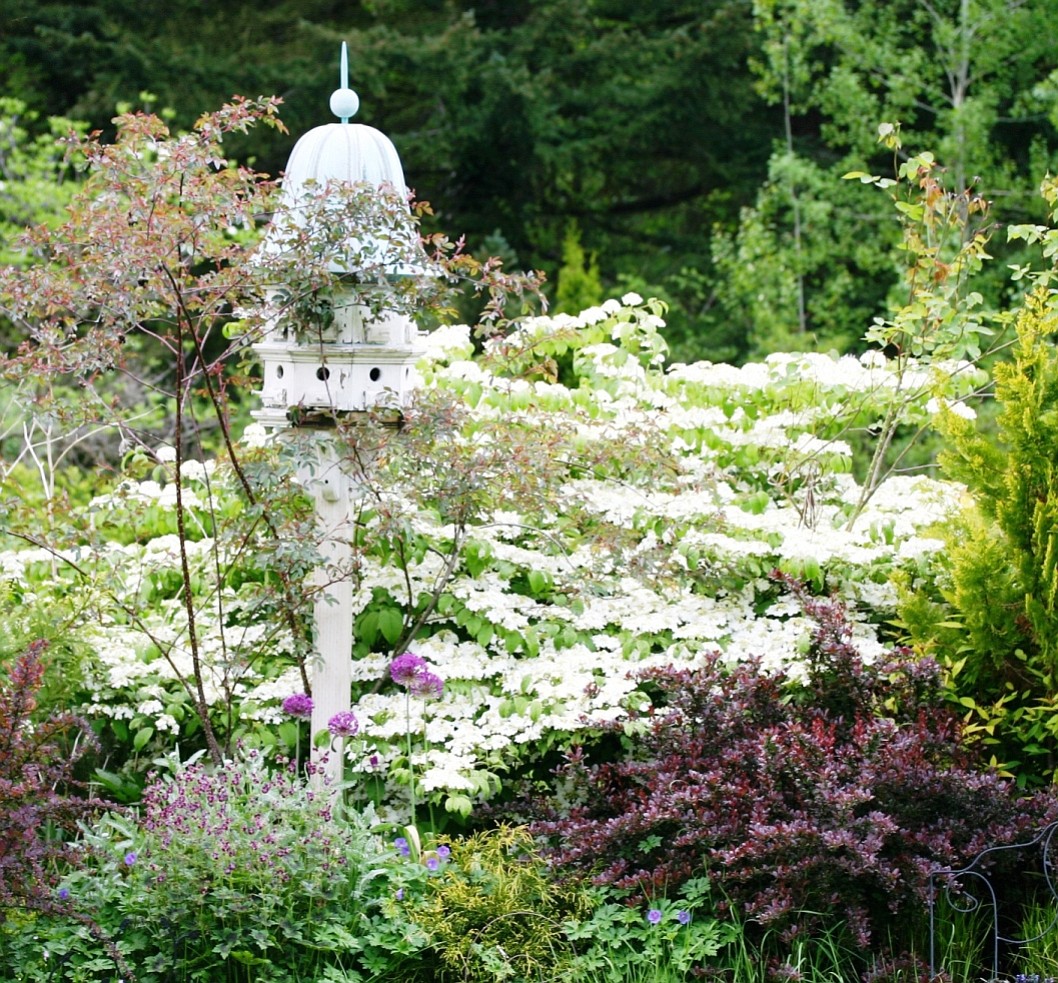In the last few weeks, I’ve had the pleasure of visiting a few neighborhoods new to me in the Vancouver area. I see a common thread in the most intriguing local gardens. The key element that draws my interest is the use of a distinct mix of trees, shrubs, vines and other woody plants to provide a solid, year-round framework.
The best take their gardens to a level of excellence by adding seasonal displays of annuals, perennials and flowering bulbs. Many woody plants are remarkably colorful with seasonal flowers, fruits, fall foliage and bark that provide long lasting beauty. Some cheerfully accept smaller plants around their feet or climbers scrambling up and over their shoulders to produce a second round of bloom.
Picture the lovely rose-pink flowering Satomi dogwood rising in elegant, branched layers above a carpet of low growing Ajuga reptans ‘Burgundy Glow’ with its soft rosy copper foliage edged in cream. For a completely different image, imagine a formal layout of pale pink roses surrounded by a boxwood hedge. The creamy white Clematis ‘Arctic Queen’ climbs an iron trellis in the center of the bed.
Both of these garden ideas were created with a mix of different types of plants including shrubs, vines and groundcovers. Building your garden scene around a mix of plant types will develop a more natural look than concentrating only on seasonal flowering perennials and annuals. This manner of combination planting results in much longer seasons of interest. A good mix of plant types is the basis of a four seasons or year-round garden.
Most gardeners are always on the lookout for new plants that are worthy of the limited space available for planting, especially those who already have established gardens. There are many reasons that we lose plants in our gardens. Drought, disease, a poor root system or soil contaminants such as herbicides and engine fuels can all cause a plant’s death. Keep in mind that even the healthiest plants have a limited life expectancy.
When a plant does die, we want to fill that space with another plant. Before you do, correct any soil conditions, especially if there is a water contamination or disease issue. When space does open up, choose a replacement that is right for the conditions available and one that fits in with the existing planting combinations. This is just one more reason to keep a running list of favorite plants on hand that you would like to see planted in your garden.
Climbing plants add a vertical element to the garden, drawing the eye up from the level of perennials and shrubbery, into the realm of trees and sky. The luminous Golden Hops will lead the eye up a tall post to a featured birdhouse. Clematis planted at the foot of an early spring ornamental tree or shrub will wend its way through the branches and peek its own blossoms out into the sunlight long after the supporting plant has finished flowering, adding another season of bloom.
As many of you know by now, the tongue twisting Ampelopsis brevipedunculata ‘Elegans’ is one of my favorite vines. Better known as the porcelain berry vine, it’s a must have plant when you see it growing well in a Pacific Northwest garden. Deeply cut leaves mottled dark green, light green and cream with subtle hints of pink in spring and fall make this vine a visual sensation. On top of that, in late summer an explosion of petite flowers will mature into shiny, enameled purple, blue and turquoise berries.
For beautiful colors, extravagance of blooms and graceful habit, few vines compare with clematis, the queen of the flowering vines. Whether used on trees, trellis or fences they enhance any planting combination. A good choice for the late season garden is Clematis paniculata, commonly known as sweet autumn clematis. This dramatic vine is stunning with pure white flowers that completely cover the plant in late summer.
Planting combinations eventually bring us back to perennial plants for the best seasonal color show. Don’t forget that foliage can often rival flowers for seasonal color. One of my most successful shady ground covers was the multi-season fern Dryopteris erythrosora ‘Brilliance’. The bright orange-red fronds emerge in spring like a flaming torch freed from the bonds of winter and are highlighted by red spores on the undersides. Best of all, it’s a fitting groundcover that can be planted now to round out the well appointed mixed shade garden.



